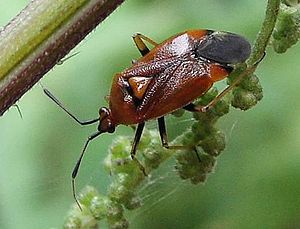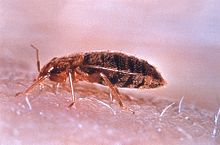Cimicomorpha
| Cimicomorpha | ||||||||||
|---|---|---|---|---|---|---|---|---|---|---|

Red soft bug ( Deraeocoris ruber ) |
||||||||||
| Systematics | ||||||||||
|
||||||||||
| Scientific name | ||||||||||
| Cimicomorpha | ||||||||||
| Leston , Pendergrast & Southwood , 1954 |





The Cimicomorpha are a suborder of the bedbugs (Heteroptera). The family group includes more than 20,500 described species in more than 2,700 genera and is thus the largest suborder of bedbugs. Most species are found in the families of the soft bugs (Miridae) and predatory bugs (Reduviidae); the most species-rich families of bedbugs at all. In Europe there are around 1700 species and subspecies of the partial order. The current taxonomic classification of the group follows the work of Randall T. Schuh and Pavel Štys from 1991, which Schuh & Slater (1995) followed. Although a more recent phylogenetic study by Schuh, Weirauch & Wheeler (2009) revealed discrepancies, particularly in the relationship of the Thaumastocoridae family , there were no sufficiently well-founded results for changing the classification.
features
The head of the bedbugs is often directed forward (prognath), with the labium in front and the frontal plate ( clypeus ) more or less dorsal and in an almost horizontal position. In the species whose head is not very prognathic, the labium lies in front on the ventral side and the frontal plate is in front and more or less in a vertical position. Trichobothria are often found on the head and the antennae are flagellate. The labium has three or four members.
In individuals with fully developed (macropter) wings , the front wings are always formed as hemielytres , the front part of which is strongly sclerotized , leathery and the rear part is membranous. Often there is a medial and a costal interruption in the wing veins . The membrane carries one to three closed cells or a few, free or no wing veins or 10 to 20 wing veins that originate from closed cells. The hind wings usually have a simple, non-branching sector of the R + M vein. The tarsi are usually three, sometimes two-part. The pretarsus is symmetrical in most families and has no arolia in either the nymphs or the adults . The claws are simple; Pulvilli and other appendages on them are not formed , with the exception of many soft bugs and some Thaumastocoridae and flower bugs (Anthocoridae). The evaporation area of the olfactory gland openings on the metathorax usually has clearly recognizable growths.
The stigma on the first abdominal segment is formed in some species, the other stigmas always lie on the ventral side of the body on a laterosterite or the mediosternal plate, in which case a laterotergite may or may not be present. The spermatheca of the females is not used for sperm storage and is either receded and transformed into a worm-shaped gland, or is absent. The paramers are directed forward.
In the case of eggs, the micropyle is usually clearly differentiated from the aeropylae . Both are arranged in a ring outside the operculum .
Way of life
The group includes only ground-dwelling species. Originally the animals presumably lived exclusively predatory, in addition to these and parasitic species, the family today also includes families that suckle on plants such as the soft bugs, net bugs (Tingidae) and Thaumastocoridae. Many species are of economic relevance , particularly in the tropics as pests and carriers of diseases, but also in biological pest control .
Taxonomy and systematics
The taxon was first described by Leston , Pendergrast & Southwood in 1954. The following authors viewed their scope very differently. In his works from 1968 and 1978, Cobben considered the assignment of the predatory bugs and Thaumastocoridae to be incorrect and assigned the Pachynomidae to the sickle bugs (Nabidae), whereas Caryon (1950), Davis (1969) and Caryon & Villiers (1968) assigned them the predatory bugs. A multigene study from 2012 not only confirmed the monophyly of the seven partial orders of the bedbugs due to molecular phylogeny, it also showed that the cimicomorpha is most likely closely related to the partial order of the pentatomomorpha .
The current taxonomic classification of the subgroups of the Cimicomorpha follows the work of Randall T. Schuh and Pavel Štys from 1991, which Schuh & Slater (1995) followed. Although a more recent phylogenetic study by Schuh, Weirauch & Wheeler (2009) revealed discrepancies, there were no sufficiently well-founded results for changing the classification. The investigation found large discrepancies in the monophyly and phylogenetic position of the family Thaumastocoridae and the position of Cimiciformes - the taxon that the Velocipedidae , Medocostidae , Nabinae , Prost Emma Tinae , Joppeicidae , Microphysidae and Cimicoidea includes - in relation to the Pentatomomorpha and the other families of cimicomorpha . However, the investigation could also show the monophyly of the Reduvioidea , the predatory bugs (Reduviidae), the Cimicoidea including the Curaliidae , the net bugs (Tingidae) and the soft bugs (Miridae). In addition, it was shown that the latter two families very likely form a monophyletic taxon, so that the superfamily Miroidea without Thaumastocoridae is accordingly certainly monophyletic. The relationship of the soft bug subtaxa remained largely unclear. The monophyly of the Cimiciformes turned out to be likely. The sister group of the Cimiciformes would therefore be the superfamily Miroidea without Thaumastocoridae.
According to Schuh & Štys (1991), the partial order includes the following superfamilies and families, supplemented by the Curaliidae, which was first described in 2008 as the youngest family of bed bugs:
- Superfamily Cimicoidea
- Flower bug family (Anthocoridae)
- Flat bugs family (Cimicidae)
- Family Lasiochilidae
- Family Lyctocoridae
- Family Plokiophilidae
- Family Polyctenidae
- Superfamily Joppeicoidea
- Family Joppeicidae
- Superfamily Microphysoidea
- Family microphysidae (Microphysidae)
- Superfamily Miroidea
- Soft bug family (Miridae)
- Family Thaumastocoridae
- Family net bugs or lattice bugs (Tingidae)
- Superfamily Naboidea
- Family Medocostidae
- Sickle bug family (Nabidae)
- Superfamily Reduvioidea
- Family Pachynomidae
- Family bugs (Reduviidae)
- Superfamily Velocipedoidea
- Family Curaliidae
- Family Velocipedidae
supporting documents
Individual evidence
- ^ A b c Robert G. Foottit, Peter H. Adler: Insect Biodiversity: Science and Society . Wiley-Blackwell, New York 2009, ISBN 978-1-4051-5142-9 , pp. 228 .
- ↑ Hong-Mei Li, Ri-Qiang Deng, Jin-Wen Wang, Zhen-Yao Chen, Feng-Long Jia, Xun-Zhang Wang: A preliminary phylogeny of the Pentatomomorpha (Hemiptera: Heteroptera) based on nuclear 18S rDNA and mitochondrial DNA sequences. In: Molecular Phylogenetics and Evolution. 37, 2005, pp. 313-326.
- ↑ Cimicomorpha. Fauna Europaea, accessed July 12, 2014 .
- ↑ a b Randall T. Schuh, Christiane Weirauch, Ward C. Wheeler: Phylogenetic relationships within the Cimicomorpha (Hemiptera: Heteroptera): a total evidence analysis. In: Systematic Entomology. 34, 2009, pp. 15-48.
- ↑ a b c d e f g RT Schuh, JA Slater: True Bugs of the World (Hemiptera: Heteroptera). Classification and Natural History. Cornell University Press, Ithaca, New York 1995, pp. 146ff.
- ↑ a b Randall T. Schuh, Christiane Weirauch, Thomas J. Henry, Susan E. Halbert: Curaliidae, a New Family of Heteroptera (Insecta: Hemiptera) from the Eastern United States. In: Annals of the Entomological Society of America. 101 (1), 2008, pp. 20-29. doi : 10.1603 / 0013-8746 (2008) 101 [20: CANFOH] 2.0.CO; 2 .
- ↑ a b Ekkehard Wachmann , Albert Melber, Jürgen Deckert: Bugs. Volume 1: Cimicomorpha: Dipsocoromorpha, Nepomorpha, Gerromorpha, Leptopodomorpha, Cimicomorpha (part 1) (= The animal world of Germany and the adjacent sea parts according to their characteristics and according to their way of life . 77th part). Goecke & Evers, Keltern 2006, ISBN 3-931374-49-1 , p. 100 .
- ↑ Min Li, Ying Tian, Ying Zhao, Wenjun Bu: Higher Level Phylogeny and the First Divergence Time Estimation of Heteroptera (Insecta: Hemiptera) Based on Multiple Genes. In: PLoS ONE. 7 (2), 2012, p. E32152. doi: 10.1371 / journal.pone.0032152 (open access)
literature
- RT Schuh, JA Slater: True Bugs of the World (Hemiptera: Heteroptera). Classification and Natural History. Cornell University Press, Ithaca, New York 1995.